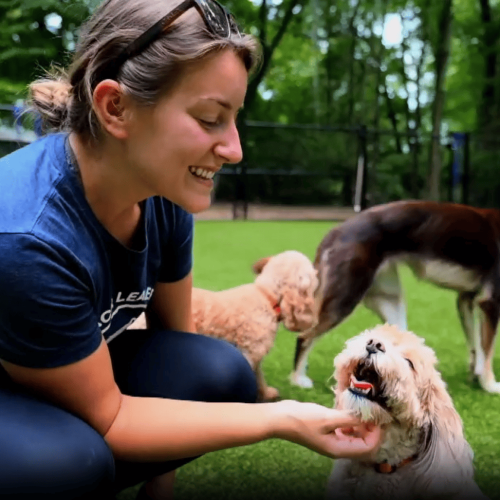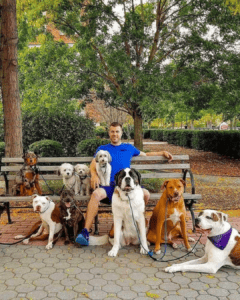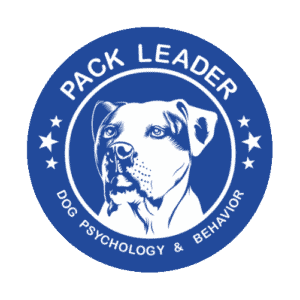Positive reinforcement is a term that can be seen and heard quite frequently in relation to dog training. As with many things related to the “Dog Training” world, how and when it’s applied while working with dogs is where the controversy ensues.
What exactly is positive reinforcement? The definition, according to Dictionary.com, says positive reinforcement is the offering of desirable effects or consequences for a behavior with the intention of increasing the chance of that behavior being repeated in the future. To make it simple in dog terms, a dog does something we like and we reinforce it with something the dog likes. The intention is to increase the probability of the thing you like with repetitions.
Sounds great, right? It is. Positive reinforcement is something we use A LOT. It’s a huge part of teaching a dog what we want and what’s expected of them. The problem is that many people are led to believe that positive reinforcement is all you need in “dog training.” I’ve worked with hundreds of clients who have previously worked with “100% positive trainers” or “all positive trainers” or “positive reinforcement based” or some form of “positive reinforcement” in their title. It looks amazing on paper and sounds great. No corrections, just reward good behavior and you’re all set. Who wouldn’t want to sign up for that? The problem is that using only positive reinforcement does not work on all dogs and can actually cause behaviors to become worse, or in some cases much worse.
Let me explain. “Dog training” focuses on saying a command, achieving a desired physical state from the dog and reinforcing that physical state with a reward (food, toy, praise, etc.). For instance, say “sit,” the dog puts his butt on the ground and the handler reinforces with a reward when the dog completes that physical state.
The problem is, we find many “dog trainers” forget about the mental state of a dog while applying positive reinforcement. One of the most common things I see are owners with reactive dogs who have used “positive only training” in the past with little to no results and even increased reactions. What these owners are usually told is that when another dog appears, use a reward (food, toy, etc.), tell the dog to sit and “look at me” and then reward by offering the food (positive reinforcement) for focusing on you and not the other dog. Sounds good, only problem is what exactly are they positively reinforcing?
By understanding dog psychology, it’s easy to see that what’s really happening is the dog gets excited about the presence of another dog, is then distracted (redirected) by the reward, becomes fixated on the reward (not the owner) in an excited state, gets the reward (positive reinforcement) in an excited state which only nurtures excitement and then the dog goes back to looking for that dog or another dog in a continued excited state. This only increases excitement levels by rewarding the dog in an excited state and teaches the dog to be fixated on the reward (food, toy, etc.), not the owner, which now causes the owner to be dependent on those rewards for distraction (redirection) in the presence of another dog. This becomes a band aid solution. It deals with the symptoms which are a dog becoming over-excited about the presence of another dog and teaches the dog to just channel that excitement towards a reward instead. It never addresses the underlying core problem of the dog being over-excited about the presence of other dogs. Rewarding in a high level of excitement can actually increase that excitement long-term with every repetition. Please understand that excitement isn’t always happiness.
I know there is some confusion in the dog world when it comes to this. Dogs can be happy at a low level of excitement as well as high level of excitement. They are 2 separate things. On the flip side, dogs are also excited when they are in a fight, barking uncontrollably, pulling on leash or attempting to bite which are undesirable behaviors where a dog is surely not happy.
To be fair, this method of using a reward to distract a dog from a certain behavior does work in some scenarios. The point we’re trying to make is it definitely does not work with all dogs. In my experience, it works with a small percentage of dogs but it does indeed work in some cases.
Now let me break it down how we address the same situation of a reactive dog. There’s A LOT that goes into it as every dog and situation is different but let me try to summarize. When a reactive dog sees another dog and begins to get excited it’s imperative that we correct or interrupt that behavior first before attempting redirection. A dog needs to understand that you disagree with the excitement towards another dog and what you expect is calmness. Once calmness is achieved in the presence of another dog, THEN a reward can be given to the dog (positive reinforcement) so they understand what’s expected of them. The dog then learns that when they are CALM, they will receive a reward (positive reinforcement). After repetitions, the dog will begin to learn that staying calm is the behavior being rewarded, not staring at food in an excited state of mind. Remember, there is a difference between quiet and calm but we’ll get into that in another post.
Let’s put it into human terms. Let’s say you’re walking down the street with a child and every time you walk by a person, the child tries to frantically punch that person. Option 1 (positive reinforcement only) would be to bring candy with you anytime you bring your child out in public. As soon as your child sees a person coming, they get worked up and yell at that person in a frantic state. You then pull out a bag of M&M’s and try to distract the child from the passing person and bribe them with the candy. As soon as the person passes, you give the child M&M’s while they are still worked up. Yikes. Option 2 (Correcting unwanted behavior) would be as your child begins to get worked up, you let them know you disagree with that behavior in a calm and confident manner. The child learns that yelling at people frantically is an unacceptable behavior in public. Later, you walk by somebody and your child stays calm and doesn’t attempt to punch the person to which point you could reward with M&M’s or even better…your affection! Your child clearly understands what’s expected and what we disagree with. They realize that when they are calm and behave, a reward may follow! Seems much better than bribing, doesn’t it?
We’ve had so much success going with option 2 over the years. I fully understand that option 1 is just that, an option. Will it work in some cases, I suppose so. Just like it can work with certain dogs. We strongly feel that option 2 works better because the dog clearly understands what’s right and what’s wrong. They learn yes and they learn no.
Jumping is another great example. The “all positive” group will just ignore all bad behaviors and reward only good behaviors. Remember, good behaviors are all in context as we discussed earlier. A dog staring at food in an excited state is not good behavior in our mind but the goal for many people and trainers. In the same instance of a dog jumping, the “all positive” group will negatively punish that behavior. Negative punishment is withholding something the dog wants when he jumps on you (such as food). When the dog eventually stops jumping, you then provide the reward which is the positive reinforcement. Sounds great again, right? With some dogs, this method can work, with others you become a piece of agility equipment that the dog enjoys disrespectfully jumping all over. We’ve had clients who told us that 6 sessions in, their dog was still intensely jumping all over the trainer with no improvement.
Even worse, clients have told me that they were told to make a high pitch squeal so the dog knows it’s hurting you and to turn away which they’ve been told over time will get the dog to stop jumping. In my opinion, by doing so we’re showing a dog that our energy is weaker than theirs which in dog psychology world means we become a follower. I’ve also had clients tell me that the high pitch squeals only intensified the jumping to which trainers told them, “it will eventually work but it takes time.” Sometimes, nail scrapes and being knocked over daily doesn’t allow for much time.
What do we do for jumping? When a dog jumps, we apply a leash correction so the dog clearly understands that jumping is not an acceptable behavior. Instead of turning away, the human walks towards the dog claiming their space, something a leader would do in a dog’s mind. Space is a HUGE part of a dog’s psychology which is rarely discussed. We repeat the approach and when a dog doesn’t jump or waits calmly we THEN give a reward such as food, toy or even better, affection which is the positive reinforcement. Again, the dog clearly learns right and wrong.
The overall point here is that positive reinforcement is a fantastic thing when working with a dog. We use a ton of positive reinforcement in our training but we don’t limit ourselves to only positive reinforcement. What’s unfortunate is when people claim they use “positive only training” because it looks good on paper and sounds good to prospective clients. Many aren’t actually positive only as they unknowingly use negative and positive punishment as described above. We’re not saying these are bad people. Their intentions are usually to help people and dogs but they haven’t been able to fully grasp Dog Psychology and how critical the mental state of a dog is and not just the physical state.
I truly believe that positive reinforcement is very effective in dog training. That being said, using positive reinforcement only absolutely does not work for all dogs. The major problem I have is when dog training professionals start blaming the dog or the client when the “all positive” training does not work. We’ve heard from clients that they’ve been told things such as “some dogs just don’t like other dogs” or “just avoid other dogs and people” or “just put the dog away” or “there must be something neurologically wrong so it’s best to medicate or euthanize.” It’s completely unethical. Even worse, as a defense mechanism because their methods aren’t working, some of those same trainers will viciously attack and bully anyone who disagrees with their methods or offer other options. When clients ask questions because results are limited, they fill their clients heads with fear and propaganda by telling them that correcting their dog will cause fear, intimidation and only make things worse. Believe it or not, numerous “positive based” trainers have contacted me and asked for help anonymously with cases where they were stuck or not able to achieve results. Why anonymously? Out of fear that they would be attacked by other “positive based” trainers.
The reality of the situation is that dog professionals should all have the same goal of helping dogs and clients. Any time spent attacking other trainers or even worse, clients, is a waste of time that could have been used towards helping a dog or a human understand dog psychology or even better learning more about dog psychology themselves.
I can tell you that after working with thousands of dogs and rehabilitating some of the most extreme cases, calm confident corrections with the right timing will not cause fear, intimidation or make things worse. They actually create clarity for a dog to understand what is allowed and what isn’t allowed. That clarity along with following the Principles of Dog Psychology is what brings dogs back to balance.
In closing, positive reinforcement is fantastic. About 90% of the time we are working with dogs, we are positively reinforcing calm, following, respectful, good behavior. There are absolutely times where a dog must be corrected or interrupted so they understand a behavior they are exhibiting is unacceptable just like a child needs to understand that yelling at people walking by is unacceptable. Calm, following, respectful, good behavior should always be reinforced in a positive way.
We refer tons of clients to other trainers across the US and internationally when location makes it impossible to work with us. If we don’t know a trainer in the client’s location, we always tell them to ask any prospective trainer or behaviorist to provide testimonials and results. The proof is in the pudding. We’ve helped so many people who were told their dog should be medicated, isolated or even euthanized by positive only trainers. Ironic, right? It needs to stop. Don’t be fooled by all the fancy science talk or be intimidated by someone who isn’t providing you results. Early in life, I was just a dog owner trying to figure out why the trainer for our family dog wasn’t getting us any results. I hope this blog gave you a better understanding about the real truth of positive reinforcement.
Stay calm and confident! ????




